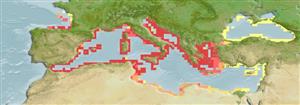Common names from other countries
>
Eupercaria/misc (Various families in series Eupercaria) >
Labridae (Wrasses)
Etymology: Symphodus: Greek, syn, symphysis = grown together + Greek, odous = teeth (Ref. 45335).
More on author: Linnaeus.
Issue
See nomenclatural details in Eschmeyer (CofF ver. Oct. 2012: Ref. 92135).
Environment: milieu / climate zone / depth range / distribution range
Écologie
marin récifal; profondeur 1 - 30 m. Subtropical; 47°N - 30°N, 6°W - 42°E
Eastern Atlantic: throughout the Mediterranean, Black Sea and Sea of Azov.
Length at first maturity / Taille / Poids / Âge
Maturity: Lm 4.0 range ? - ? cm
Max length : 18.5 cm TL mâle / non sexé; (Ref. 122896); poids max. publié: 81.69 g (Ref. 122896); âge max. reporté: 5 années (Ref. 4742)
Adults are found near rocks and eel-grass beds. A nest of seaweed (Cystoseria) built and kept by male. Feed on bryozoans, hydroids, tubicolous, worms, shrimps, amphipods and mollusks. Males grow faster than females (Ref. 4742). Undergoes sex reversal (Ref. 4742). Oviparous, distinct pairing during breeding (Ref. 205).
Undergoes sex reversal (Ref. 4742). Oviparous, distinct pairing during breeding (Ref. 205). Males build dish shaped nests and guard the eggs (Ref. 205).
Quignard, J.-P. and A. Pras, 1986. Labridae. p. 919-942. In P.J.P. Whitehead, M.-L. Bauchot, J.-C. Hureau, J. Nielsen and E. Tortonese (eds.) Fishes of the north-eastern Atlantic and the Mediterranean. UNESCO, Paris. Vol. 2. (Ref. 4742)
Statut dans la liste rouge de l'IUCN (Ref. 130435)
CITES (Ref. 128078)
Not Evaluated
Menace pour l'homme
Harmless
Utilisations par l'homme
Aquarium: Commercial
Plus d'informations
RéférencesAquacultureProfil d'aquacultureSouchesGénétiqueElectrophoresesHéritabilitéPathologiesTraitementMass conversion
Outils
Articles particuliers
Télécharger en XML
Sources Internet
Estimates based on models
Preferred temperature (Ref.
115969): 16.5 - 21.1, mean 18.9 (based on 421 cells).
Phylogenetic diversity index (Ref.
82804): PD
50 = 0.5005 [Uniqueness, from 0.5 = low to 2.0 = high].
Bayesian length-weight: a=0.01202 (0.00993 - 0.01456), b=3.09 (3.05 - 3.13), in cm Total Length, based on LWR estimates for this species (Ref.
93245).
Niveau trophique (Ref.
69278): 3.5 ±0.0 se; based on diet studies.
Résilience (Ref.
120179): Milieu, temps minimum de doublement de population : 1,4 à 4,4 années (K=0.64-0.95; tm=1-2; tmax=5).
Fishing Vulnerability (Ref.
59153): Low vulnerability (22 of 100).
